Jacob van Eyck Quarterly 2001, No. 3 (July)
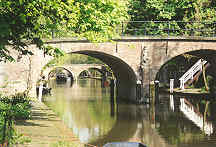
Most bridges
over the canal connect cross-streets. The Weesbrug forms an exception:
there are houses on both sides. The Regulieren (Regular's) monastery
stood West of the bridge. It was turned into an orphanage after the Reformation.
(Nowadays it is the location of a pop music concert hall, Tivoli.)
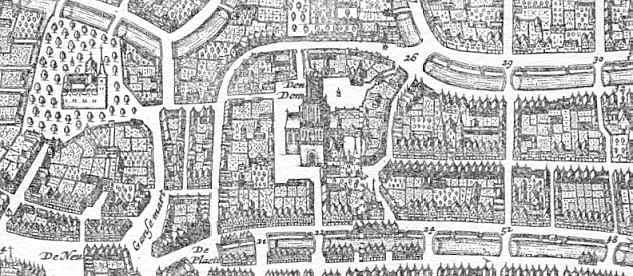
Map of Utrecht
by J. Blaeu, 1649 (detail). Showing the Janskerk with Janskerkhof (left),
the Dom Cathedral and the Reguliers- or Weesbrug (right, bottom: No. 48)
The exact location where van Eyck lived remained a mystery for centuries,
as he never owned a house in Utrecht. The whereabouts of tenants are usually
difficult to trace in archives. Nevertheless, it turned out to be possible
in van Eyck's case. The solution bears a name: Johan Dicx (Dix). He succeeded
van Eyck as carillonneur of the Dom Cathedral, and was probably a former
pupil. Recorder variations by Johan Dicx, clearly showing van Eyck's influences,
appeared in the anthology 't Uitnemend Kabinet.
In 1646, van Eyck wrote to Constantijn Huygens that he was feeling the first infirmities of old age. In 1654, the year when Der Fluyten Lust-hof II received its second printing, he had his will drawn up, stating that 'considering human sickness, nothing on earth is more certain than death and nothing less certain than its hour'. Johan Dicx was appointed executor of the will. Van Eyck left all his possessions in Utrecht as well as a hayfield in Brabant to him. From that time onwards, the blind master's health may have declined. On 8 October 1655 the Dom authorities allowed Johan Dicx to take over van Eyck's duties 'during his illness'.
Johan Dicx was married to Maria van Schagen, daughter of the surgeon Peter van Schagen. On 30 March 1654, when their first child was baptized in the Dom Cathedral, they lived at the Oudkerkhof ('Old Churchyard'), a street halfway between the Dom and the Janskerkhof (St John's Churchyard). Maria had inherited this house upon her father's death. On 7 August 1656 however, when a second child was baptized, Dicx stated that he lived at the Reguliersbrugh, which was also van Eyck's address... The following had happened: in the meantime Johan Dicx had sold his house at the Oudkerkhof to Johan van Nellesteyn, one of Utrecht's burgomasters. Van Nellesteyn sold one of his own houses, situated on the Oudegracht at the Reguliersbrug, to Johan Dicx. This is the important clue.
It is not
difficult to grasp the reason for the exchange. In 1628, the Utrecht authorities
had stipulated that van Eyck was to keep his salary until his death, even
if someone else took over his position at an earlier date. Johan Dicx
therefore didn't receive any salary as van Eyck's substitute. Buying the
house where van Eyck lived was a practical solution. The old master's
salary, or at least a part of it, could go to Johan Dicx, in exchange
for board and lodging. And the Dicx family could keep an eye on him.
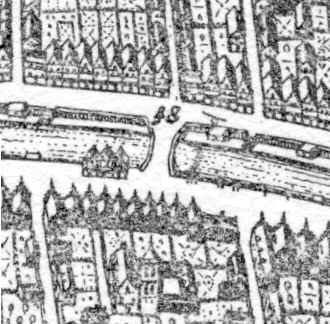
< Reguliers-
or Weesbrug, with Weeskerk (bottom), seen from the west. The house where
van Eyck lived, is to be found left above the '4' of '48'. Move the cursor
over the picture to find the several locations.
The map is not in accordance with the real situation: here the alley (Reguliersteeg),
and not van Eyck's house, finds itself opposite to the bridge.
Van Nellesteyn's premises were situated on the east side of the Oudegracht.
It was the second house north of the Reguliersteeg (Regular's Alley).
In 1623, the house was known as 't Gouden Lam (The Golden Lamb).
Today the address is Oudegracht No. 262. The façade has got an
18th- or early 19th-century look to it now.
It is the only house on that side of the Oudegracht that fully faces the bridge, showing how literally the circumscription 'at the Regular's Bridge' had to be taken. No contemporary drawings or paintings are further known, except for bird's-eye maps.
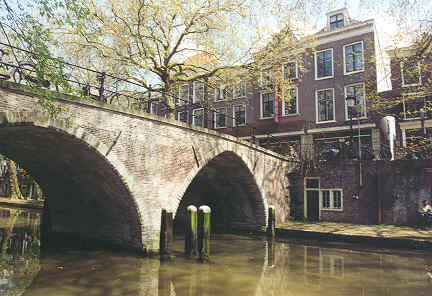
Weesbrug,
with the house where Jacob van Eyck lived (move the cursor over the picture
to find it). On the right, under the small arch, is the Reguliersteeg
(Regular's Alley)
There is a 1744 drawing by J. de Beijer, showing the Reguliers- or Weesbrug
from the side where van Eyck lived (de Beijer sat a little south of the
Regular's Passage). The Orphanage stood across the bridge and the Reguliers-
or Weeskerk, where the carillonneur and recorder player was buried. These
are the buildings van Eyck would have seen out of his window, when born
with light in his eyes...
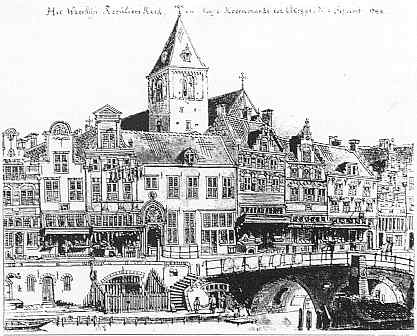
< Weesbrug,
Weeskerk and Weeshuis in 1744 (Drawing by J. de Beijer)
The same area, today... >
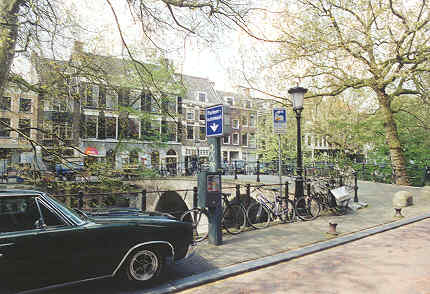
Thiemo Wind
No. 4 will be available on 1 October, 2001
Do you want to receive a reminder? Send a mail:
Did you reach this page through a search engine? Click below to go to the